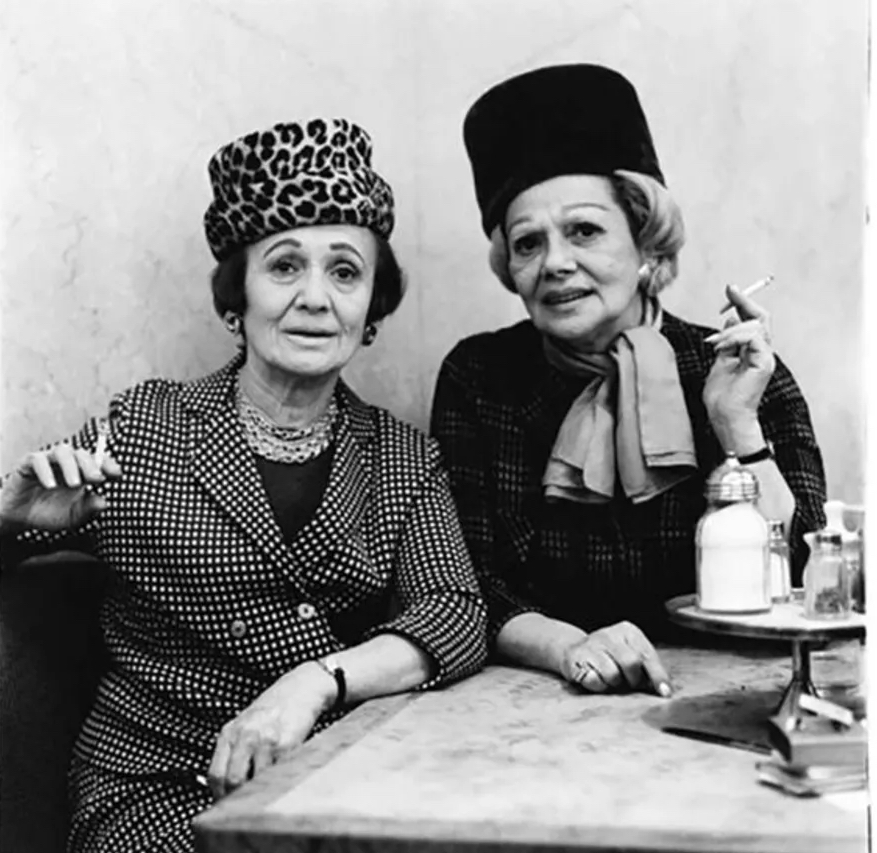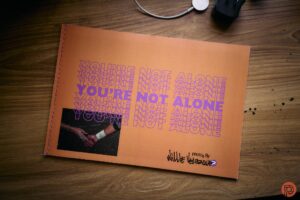Diane Arbus’s Two Ladies at the Automat, NYC, 1966 is a striking example of her ability to reveal the profound within the mundane, the extraordinary within the seemingly ordinary. Known for her empathetic and unflinching lens, Arbus’s work often focuses on individuals and moments that exist on the margins of mainstream society. This photograph encapsulates her mastery in capturing both the specificity of her subjects and the universality of their humanity, inviting viewers into a world at once intimate and enigmatic.
The Automat: A Cultural and Historical Context
In the mid-20th century, automats were a quintessential part of urban American life, particularly in cities like New York. Functioning as self-service cafeterias, they offered affordable, quick meals to a diverse clientele. These establishments became cultural microcosms, where people from all walks of life brushed shoulders—office workers, artists, the wealthy, and the destitute. For photographers like Diane Arbus, the automat was a space rich with stories, a stage where the small dramas of daily life played out against a backdrop of chrome fixtures and fluorescent light.
In Two Ladies at the Automat, Arbus transforms this unremarkable setting into something profound. The automat becomes not just a physical space, but a psychological one, a liminal zone where the boundaries of identity, class, and self-presentation blur. The photograph captures two women seated at a table, their expressions, attire, and body language steeped in a mixture of intimacy and mystery.
The Subjects: Two Women, Infinite Stories
The central figures in Two Ladies at the Automat are an enigmatic pair of women who seem, at first glance, utterly ordinary. Yet, as with much of Arbus’s work, their ordinariness is a veil that invites deeper scrutiny. Their carefully chosen outfits, their makeup, and the way they occupy the space suggest lives that are both performative and deeply personal.
One of the women wears a fur coat and a headscarf, her lips painted dark. The other, slightly younger, is dressed more modestly, her gaze more cautious. Their faces are lined, hinting at age, experience, and perhaps weariness. Arbus captures them in a moment of quiet pause, their expressions ambiguous—somewhere between confidence and vulnerability, between companionship and solitude.
The ambiguity of their relationship is a hallmark of Arbus’s approach. Are they sisters? Friends? Lovers? The photograph provides no answers, leaving viewers to project their interpretations onto the scene. This open-endedness is central to the power of Arbus’s work, as it compels viewers to confront their assumptions and biases.
Themes of Identity and Self-Presentation
Arbus was deeply interested in the ways people construct and present their identities, often focusing on those who existed outside societal norms. In Two Ladies at the Automat, this theme is evident in the women’s clothing and demeanor. Their carefully applied makeup and well-kept outfits suggest a desire to project dignity and style, even in a humble setting. Yet there is also a sense of incongruity—the glamorous fur coat juxtaposed against the utilitarian backdrop of the automat speaks to the complexity of their lives, a tension between aspiration and reality.
The photograph raises questions about the societal roles these women occupy. In 1960s America, women were often defined by their relationships to men—wives, mothers, daughters—but Arbus’s image resists such reductive categorizations. These women are not defined by their connections to others; they exist as complete, self-contained individuals, their identities shaped by their own choices and experiences.
Composition and Atmosphere
Arbus’s compositional choices heighten the emotional resonance of the photograph. The framing is tight, bringing the viewer uncomfortably close to the subjects. This intimacy is a hallmark of Arbus’s style, forcing viewers to confront the humanity of her subjects without the distancing effect of a wide shot or a posed image.
The lighting in Two Ladies at the Automat is stark and unflattering, emphasizing every line and shadow on the women’s faces. This lack of romanticization is central to Arbus’s ethos as a photographer; she does not shy away from the imperfections and peculiarities of her subjects. Instead, she embraces them, presenting them as integral parts of their individuality.
The automat’s interior adds another layer to the photograph’s atmosphere. The harsh fluorescent lighting, the utilitarian furniture, and the faint reflections in the chrome surfaces create a sense of alienation. Yet within this impersonal environment, the connection between the two women feels deeply human. This interplay between isolation and intimacy is a recurring theme in Arbus’s work, reflecting the paradoxical nature of urban life.
The Psychological and Emotional Flow
One of Arbus’s great achievements in Two Ladies at the Automat is her ability to evoke a complex range of emotions. The photograph is at once tender and unsettling, inviting both empathy and unease. The women’s expressions are inscrutable, yet they seem to carry the weight of untold stories—of hardships endured, of moments of joy and connection, of a life lived in the margins.
This emotional ambiguity is part of what makes Arbus’s work so enduring. Her photographs do not offer easy answers or neatly packaged narratives. Instead, they invite viewers into a space of uncertainty, where they must grapple with their own feelings and interpretations. In this way, Two Ladies at the Automat becomes a mirror, reflecting not just the lives of its subjects, but also the viewer’s own assumptions and emotions.
Arbus’s Larger Body of Work
To fully appreciate Two Ladies at the Automat, it is essential to situate it within the context of Arbus’s broader body of work. Throughout her career, Arbus was drawn to individuals and communities that existed outside societal norms—circus performers, transgender individuals, people with disabilities. Her photographs often challenge conventional ideas of beauty, normalcy, and propriety, revealing the humanity in those who were often marginalized or misunderstood.
In this sense, Two Ladies at the Automat is both typical of Arbus’s approach and unique in its execution. While it lacks the overt eccentricity of some of her other works, it shares their underlying themes of identity, otherness, and the quiet drama of everyday life. The photograph reminds us that the extraordinary is often hidden in plain sight, waiting to be uncovered by a compassionate and discerning eye.
The Cultural Legacy of Arbus’s Work
Diane Arbus’s photographs have had a profound impact on the history of photography and on cultural understandings of identity and difference. Her work challenges viewers to see beyond stereotypes and surface appearances, to recognize the complexity and dignity of every individual. Two Ladies at the Automat is a testament to her ability to find beauty and meaning in the ordinary, transforming a moment of daily life into a profound exploration of the human condition.
In the decades since its creation, Two Ladies at the Automat has continued to resonate with audiences, serving as both a time capsule of 1960s New York and a timeless meditation on connection and individuality. Its themes remain as relevant today as they were when Arbus first captured it, reminding us of the power of photography to reveal the hidden stories that shape our lives.
Impression
Two Ladies at the Automat, NYC, 1966 is a masterpiece of quiet complexity, a work that encapsulates Diane Arbus’s unique vision and enduring legacy. Through her empathetic lens, Arbus transforms an everyday moment into a profound exploration of identity, connection, and the human spirit. The photograph invites us to look closer, to question our assumptions, and to find beauty in the unexpected. It is a reminder that within every individual lies a universe of experience, waiting to be seen and understood.
No comments yet.








